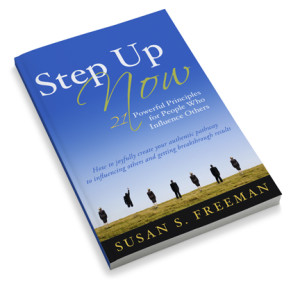Introduction from Alana:
 When our mutual friend, Brenda, originally connected Susan Freeman and myself, she must have known we would become fast friends. Susan, the author of Step Up Now: 21 Powerful Principles for People Who Influence Others, public speaker on the inner dimensions of leadership and executive coach to motivated, high-achieving leaders and influencers, inspires creativity in everyone who’s life she touches.
When our mutual friend, Brenda, originally connected Susan Freeman and myself, she must have known we would become fast friends. Susan, the author of Step Up Now: 21 Powerful Principles for People Who Influence Others, public speaker on the inner dimensions of leadership and executive coach to motivated, high-achieving leaders and influencers, inspires creativity in everyone who’s life she touches.
Given that it’s a Sunday, I thought it would help each of us to physically tap into our creativity as we prepare for the work week ahead… And, wouldn’t you it? Last month, Susan published “How to Lead from the Creative Zone,” an exceptionally useful piece which she gave me permission to share with the CLC Community. Not only will does Susan explain where our creativity comes from, she gives us pointers to physically get into the Creative Zone.
It’s my privilege to give you Susan Freeman…
———————————————————————-
Guest post from Susan Freeman, Founder and President of Step Up Leader:
 There is a common misperception that creativity is limited to a select few among us; writers, artists, musicians, or those in the “creative arts.” Nothing could be further from the truth as leadership is truly a creative endeavor.
There is a common misperception that creativity is limited to a select few among us; writers, artists, musicians, or those in the “creative arts.” Nothing could be further from the truth as leadership is truly a creative endeavor.
To create a business, product or service requires creativity. Solving problems requires creativity. Helping people develop requires creativity. In fact, developing excellence in teams and organizations comes through a creative process. Each of us has the ability to tune in to our own creativity.
What gets in the way of our doing so?
- We don’t believe that we can
- We don’t know how to access it
- We don’t trust it when we do access it
In order to tune in to your creative self, you must first learn to relax – literally, physically. When the body is dominated by the sympathetic nervous system, beta brainwaves are the norm. During most of our waking hours, we focus on conscious, rational thought. We consume ourselves with “thinking” and “doing.” This is well and good for checking things off the list. However, creativity doesn’t live here.
Creativity does live when we activate the para-sympathetic nervous system. This occurs when we are deeply relaxed. In this state, the body is dominated by alpha, or, if we are in the deepest states of relaxation, perhaps even theta or delta brain waves. This is the seat of intuition, visualization, creativity and other non-linear intelligences.
When we are in the busy, distracted day-to-day activities, we are usually reacting to external events. Creativity demands the opposite. When we are relaxed and calm, we can allow that which wants to emerge to come forth. Often it surprises or delights us.
We wonder “where did that come from?” or “I never thought about that before.” That’s because the thinking mind has its limits; the creative mind does not.
How can creativity expand when working with others? We have to see others from an open, accepting perspective. When we see from a position of judgment, we have created separation; within ourselves and between us and them. In that separation, we block creativity in ourselves and in them.
As leaders, we aim to inspire others. We hope they will care about the same vision we care about. We hope they will engage based on mutual care and commitment. By connecting to that part of ourselves, we can connect to others. When we tell or order them to do what we think they should do, we extinguish their creativity. Often, this is where dis-engagement begins.
How can leaders access creativity in themselves and others? Enter a calm state of mind and being. Use slow, long, deep belly breathing in order to dial-down the sympathetic nervous system. In a few moments you will observe things from a different perspective. Never try to “force” creativity; rather “allow” it.
See if the challenge you have lends itself to visualizing a solution; drawing and using color are often ways to explore it. I often use metaphor. My challenge is like a ….. Metaphors are a gateway to the creative mind.
To generate co-creativity with another is like being in a dance. Once you are calm and connected within yourself, you are ready to engage with others on your team. Co-creativity is established through the accepting, open-hearted, curious invitation to explore another person’s ideas and perspectives. Courageous conversations will follow.
Next time you feel as if creativity belongs to someone else, reflect on how you brought forth a creative solution. As you focus on creativity as a way of engagement, your creative muscle (and confidence) will strengthen. Leadership may become one of your favorite creative activities!